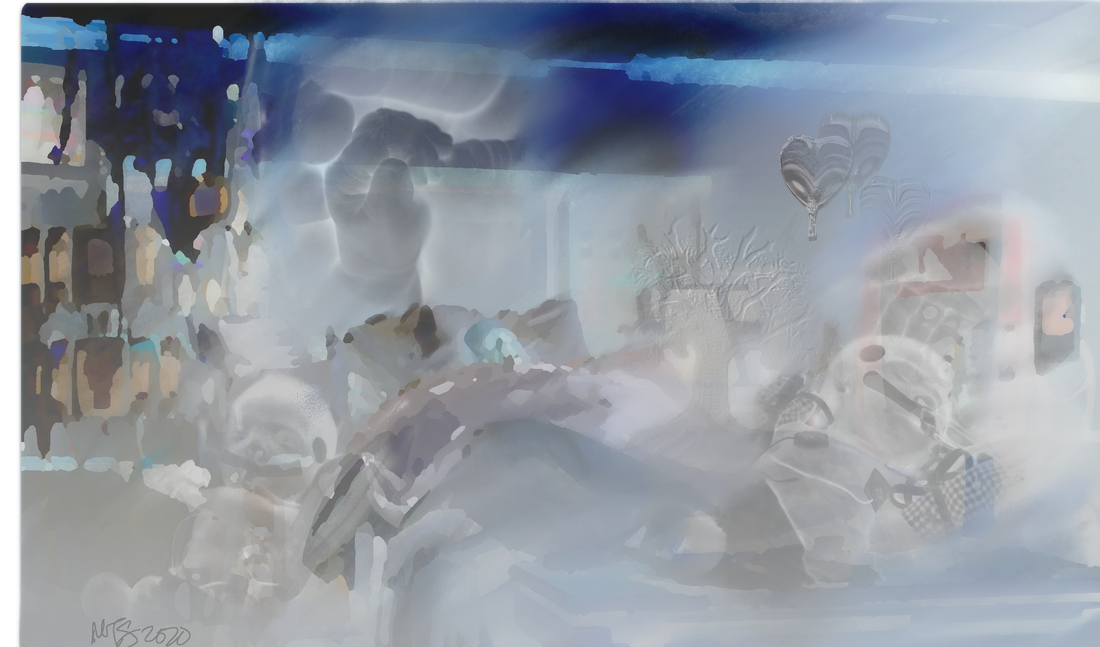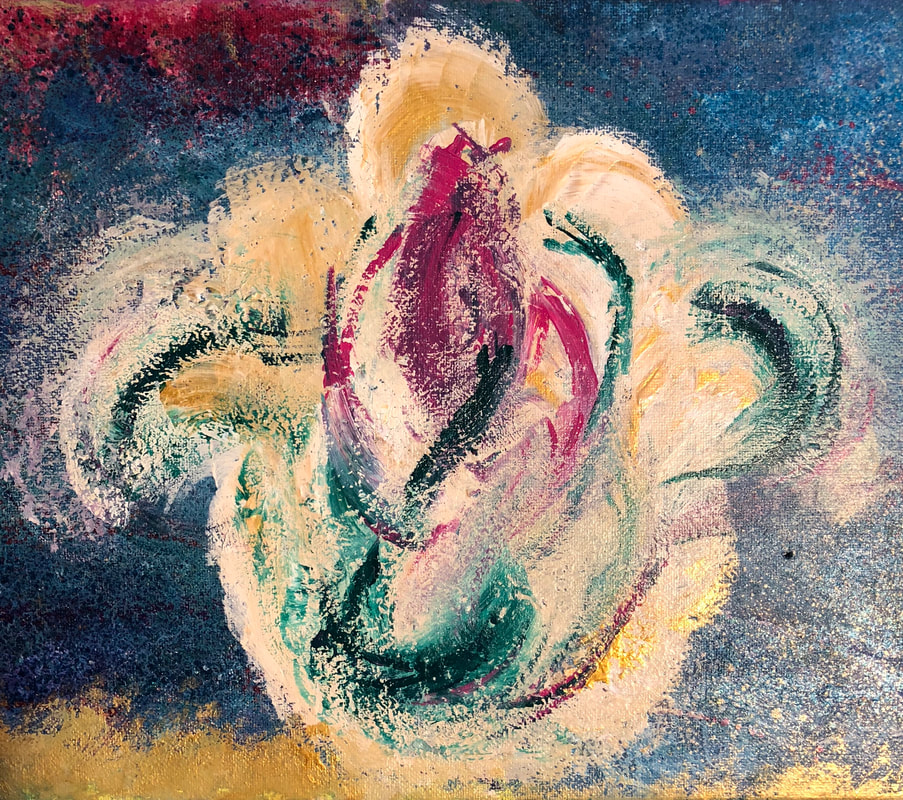|
You know it’s over when they let you enter without first scrubbing your hands.
This ends one of two ways. Only one means coming home with the one you love. Safety precautions are no easier in intensive care, just clearer. The ventilator, translucent skin, the unsteady beat of the monitors--all scream vulnerability and so, of course, of course you wash and gown and mask. That’s obvious. The dying parent. The tiny babies. Every cell in your body wants to shield them from danger, even – especially – the invisible danger clinging to you from outside, hitching a ride closer to them. Looking for a way in; their vulnerability an invitation. They can’t protect themselves. Protecting them is obvious even when it’s not easy. You respect the barriers marking the threshold between the menace outside and the relative (hoped for, prayed for) safety here, inside. When you can see blue blood rushing beneath translucent skin, it’s not hard to wash your hands. The line used to be hard and sharp. Maybe it was imaginary, but it seemed straightforward. Safety is here: danger is there. Now, the ink has smeared until that line becomes earth, becomes air encircling each of you and what does it mean to be safe now? Ah, but you know what it means to keep a distance, so that you can protect. You remember. It’s planted in the marrow of your bones. How do you love through panes of glass? With a heart beating so hard you’re certain your tiny babies must hear it, too. When you touch them with a gloved hand, is it warm? Do they know it’s you? Only your voice can touch without danger. The soft lullaby you sing into the incubators when you have to leave them. And the way his heart speeds up when he hears you coming into his hospital room. On that final morning, they let you in without scrubbing. You touch your father’s hand with yours, unwashed and ungloved, because that line doesn’t matter anymore. It’s how you know it’s over. All those years before, you got to take your babies home, drawing a new line around them, hard and strong for as long as you possibly could until you cracked it open to take them out. Out there. Unwashed hands and air travel leave them with bronchitis, but they’re stronger now and recover. You gave them time to grow and for their lungs to heal. And you know it isn’t over. It’s planted in the marrow of your bones. And now? Now you will stay away for as long as you must if it means they will be safe. You will love them again through a pane of glass (or a computer screen) when they are six-thousand miles away instead of in your kitchen, cooking and bickering, where you wish they were (where they’re supposed to be) instead. You will send your voice through the telephone and hug over a video link and listen through a window for the music you know is out there because the line defining dangerous and safe has shattered, and you will protect them with the distance that you keep because this is what you do when you love. - Visual Media and Poem by Dr. Mara Tesler Stein
0 Comments
For years I was scared to buy paint. One of my college roommates was an art major, and it captivated me to watch her paint. She had the capacity to create such beautiful, museum-quality pieces with her amazing talent. I loved to watch her work her magic! To this day I am proud to have several of her pieces and prints in my home, as I’m reminded of those beautiful memories of watching her in-the-zone.
Like many people I’ve worked with through the years, my barrier to painting and to most visual art came from a sense of “I can’t do it,” or “I’m not good enough.” I never seemed to have this issue with music, dance, theater, or writing where there was at least some evidence of my competence, usually in the form of compliments or accolades received. I never had a problem calling myself a writer, for instance, winning many awards throughout middle school and high school. And then came the books… But to call myself a visual artist? To call myself a painter? Hell no! After watching my roommate work, I still felt you had to have a special artist license to even buy paint… There is one visual form I felt reasonably comfortably approaching: collage. Born out of my love for making travel scrapbooks, collaging spoke to me because there didn’t seem to be competence involved. And I very much enjoyed the process of taking scraps and allowing them to develop into something meaningful when put together. As I began working with my own expressive arts mentor Christine Valters Paintner, I began to get braver about working with visual arts. Sure, I’d long kept some basic drawing materials in the office for my clients and out at Dancing Mindfulness retreats. Yet when I began working with Christine and realizing just how much Dancing Mindfulness as a program connected with the all-of-the-above nature of the expressive arts, I got braver about exploring my edge as an expressive artist. I continued with collage and ventured into working with pastels and markers. I quickly found that visual arts had even more to teach me because I didn’t approach them with any kind of expectation about the quality of the product. There’s something to be said about being the worst kid in art class who was never chosen for any shows. Because competence was never my focus in visual art, I was naturally more open to just enjoying it, to being in process, and learning from what making just for fun revealed. I credit crossing the paint threshold to my ex-husband after he saw how much I liked coloring and pastels. When I was going through an especially rough patch in the Fall of 2016, he bought me a paint-by-numbers kit. Although initially skeptical, I soon found that I enjoyed it even more than coloring books. There was something soothing and containing about having lines in which to work, yet my hand responded to the sensation of moving paint along a canvas. I loved everything about it; the colors, the smells, and yes, even the feeling of accomplishment when I saw the final product. There was some leftover paint and while at my local craft store on a run for some other supplies, I bought a small canvas and decided to use the leftover pain to express something original. I painted a mandala and it spoke to me very much. I continued with this process for the next few months—finishing paint-by-numbers kits and then using the leftover paint to create something original. After a couple rounds of this process, I got brave enough to order some of my own paint off of Amazon and continue with my explorations. I approached it as something fun to do, something that let me play with color and texture and sensation and not be bound by the shackles of outcome. A few months into this journey is where the painting that graces the cover of my latest book Process Not Perfection: Expressive Arts Solutions for Trauma Recovery revealed itself to me. And in this revelation came what is perhaps the greatest lesson that I ever received about the power of process: be open to where the unexpected, even the failures, may guide you. A pleasant surprise may blossom when you shed these expectations. I laid down a foundation in gauche, the first time I ever experimented with this unique form closely related to watercolor. I also played around with using some shimmery paints that you can apply with a spray bottle. I liked the mystical ocean of color that was coming into existence! Then the idea came to me—paint a Hand of Fatima! This blue magic would certainly be an ideal backdrop for this symbol I’d come to adore. I printed out a copy of the hand online to follow. This unique pattern, sometimes referred to as a Hand of Hamhsa, seemed relatively easy to copy or trace, even for someone as unskilled as I. When I looked at the lopsided result of my attempt to paint the hand in white acrylic with a fine brush, I was disheartened. “See, I ruined my cool blue background,” I huffed in frustration. In the spirit of process, I rolled with that frustration, angrily ripping away a paper towel and I just started rubbing. I hoped that enough of it would come off so that I might be able to salvage some of the base. What emerged was the cool, rather mystical white outline of a flower that you now see on the cover of the book. “Wow, the hand now looks like a cloud, or a flower,” I said. I noticed that my raging by paper towel maneuver also made some very interesting patterns on the canvas that I just began filling in with gold… and then with green. And then as I noticed the flower take shape, I finished off the core image with some of the pinkish-magenta that now composes the flower itself. I stood back in amazement, declaring, “I did that! It’s beautiful!” And it was totally an accident, the fruit of staying in process and not being fixated on outcome. From the moment I began writing Process Not Perfection, I knew that this image would be my book’s cover. For being in the process that birthed this painting is when I truly fell in love with the magic of expressive arts. I adore how the practices of expressive arts therapy invite me into a focus on process rather than perfection, and I am so grateful to be surrounded by a community of other expressive artists who inspire me to carry this lesson into all areas of my life. To the process, my friends! And to the inevitable magic that will unfold from living a life in process… |
Dr. Jamie MarichCurator of the Dancing Mindfulness expressive arts blog: a celebration of mindfully-inspired, multi-modal creativity Archives
September 2022
Categories
All
|
Contact |
Memberships & Affiliations |
|
Please direct all inquiries to:
[email protected] © Mindful Ohio & The Institute for Creative Mindfulness, 2021 Terms of Use Privacy Policy |
Dancing Mindfulness/The Institute for Creative Mindfulness is an organizational member of the International Association of Expressive Arts Therapists, the Dance First Association, and NALGAP: The Association of Gay, Lesbian, Bisexual, Transgender, Addiction Professionals and Their Allies; Dancing Mindfulness proudly partners with The Breathe Network and Y12SR: The Yoga of 12-Step Recovery in our shared missions.
|



 RSS Feed
RSS Feed